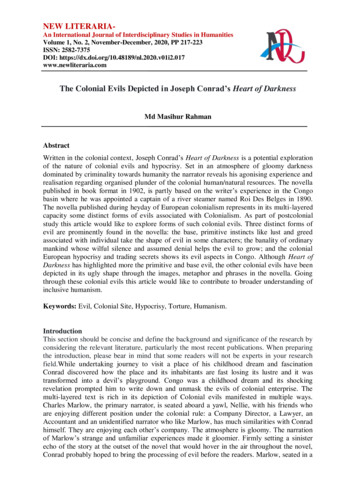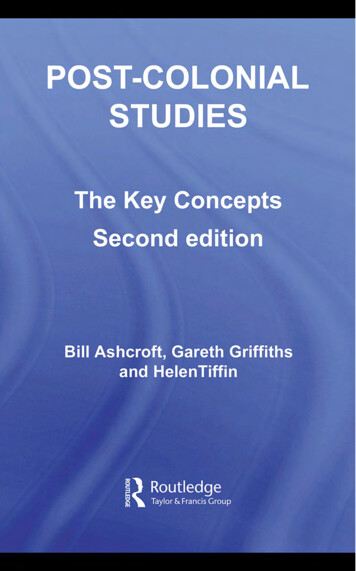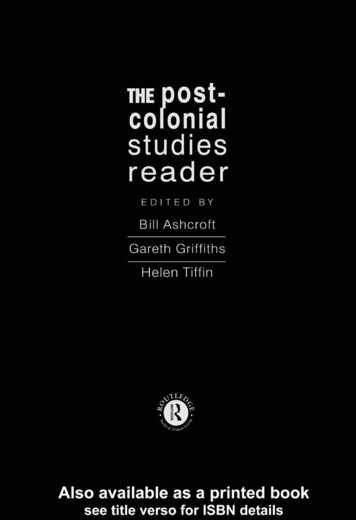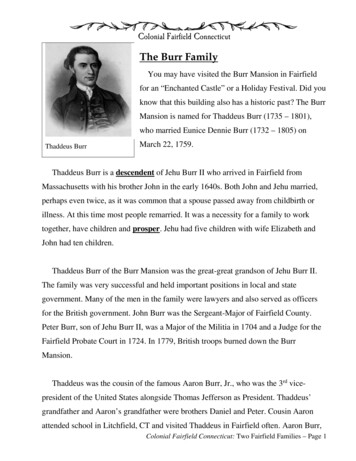
Transcription
NEW LITERARIAAn International Journal of Interdisciplinary Studies in HumanitiesVolume 1, No. 2, November-December, 2020, PP 217-223ISSN: 2582-7375DOI: ewliteraria.comThe Colonial Evils Depicted in Joseph Conrad’s Heart of DarknessMd Masihur RahmanAbstractWritten in the colonial context, Joseph Conrad’s Heart of Darkness is a potential explorationof the nature of colonial evils and hypocrisy. Set in an atmosphere of gloomy darknessdominated by criminality towards humanity the narrator reveals his agonising experience andrealisation regarding organised plunder of the colonial human/natural resources. The novellapublished in book format in 1902, is partly based on the writer’s experience in the Congobasin where he was appointed a captain of a river steamer named Roi Des Belges in 1890.The novella published during heyday of European colonialism represents in its multi-layeredcapacity some distinct forms of evils associated with Colonialism. As part of postcolonialstudy this article would like to explore forms of such colonial evils. Three distinct forms ofevil are prominently found in the novella: the base, primitive instincts like lust and greedassociated with individual take the shape of evil in some characters; the banality of ordinarymankind whose wilful silence and assumed denial helps the evil to grow; and the colonialEuropean hypocrisy and trading secrets shows its evil aspects in Congo. Although Heart ofDarkness has highlighted more the primitive and base evil, the other colonial evils have beendepicted in its ugly shape through the images, metaphor and phrases in the novella. Goingthrough these colonial evils this article would like to contribute to broader understanding ofinclusive humanism.Keywords: Evil, Colonial Site, Hypocrisy, Torture, Humanism.IntroductionThis section should be concise and define the background and significance of the research byconsidering the relevant literature, particularly the most recent publications. When preparingthe introduction, please bear in mind that some readers will not be experts in your researchfield.While undertaking journey to visit a place of his childhood dream and fascinationConrad discovered how the place and its inhabitants are fast losing its lustre and it wastransformed into a devil’s playground. Congo was a childhood dream and its shockingrevelation prompted him to write down and unmask the evils of colonial enterprise. Themulti-layered text is rich in its depiction of Colonial evils manifested in multiple ways.Charles Marlow, the primary narrator, is seated aboard a yawl, Nellie, with his friends whoare enjoying different position under the colonial rule: a Company Director, a Lawyer, anAccountant and an unidentified narrator who like Marlow, has much similarities with Conradhimself. They are enjoying each other’s company. The atmosphere is gloomy. The narrationof Marlow’s strange and unfamiliar experiences made it gloomier. Firmly setting a sinisterecho of the story at the outset of the novel that would hover in the air throughout the novel,Conrad probably hoped to bring the processing of evil before the readers. Marlow, seated in a
The Colonial Evils Depicted in Joseph Conrad’s Heart of DarknessBuddha like posture with legs crossed, back straight, arms dropped, palm in a prostrate modestarted talking about his sojourn before the group of listeners. Evening darkness descendsmaking the story teller a mystical body. Our narrator who is recollecting the whole thingbefore us is hypnotized. In fact, the narrator is feeling compelled to disseminate Marlow’sstory before the readers who would be awakened to a fresh way of ethical thoughts aboutColonialism and its associated evils. Conrad’s contribution to reformation and humanity liesin the understanding and depiction of the origin and nature of evil in Heart of Darkness: theprimordial, corrupting and self-eroding temptation of evil inside the human heart; thedarkness in the so-called progress of civilization and the banal evil found in decent andordinary people like Marlow. Although there are other sources of evil found here, the novellais more fascinated with the primordial manifestation of evil.1.1.1 Historicizing the colonial evils depicted in “Heart of Darkness”:During 1890’s when Conrad was searching a job as captain to go to his dream point, therewas headlines in London about the successful Emin Pasha Relief expedition of HenryStanley1. Like Conrad everybody with some idea about Africa firmly believed about thesehighlighted campaigns which were assumed to be conducted to civilize and enlighten theignorant people of Africa. According to Adam Hochschild, “in the nineteenth centuryEuropean drive for possessions in Africa, people justified colonialism in various ways,claiming that it Christianized the heathen or civilized the savage races or brought everyonethe miraculous benefits of free trade” (Hochschild 1999, p.38). The Victorian moralsensibilities took these noble causes heartily. Joseph Conrad was appointed captain ofa riversteamer Roi Des Belges by a Belgian Trading Company. During his trip to Congo Conradwitnessed “evidence of atrocities, exploitation, inefficiency, and hypocrisy and it fullyconvinced him of the disparity of imperialism’s rhetoric and the harshest reality” (Watts1996, p.48) of looting. Conrad saw forced labour and corruption perpetrated by King LeopoldII’s agents in Congo 2. According to Peter Eichstaedt, by taking Congo as his personalproperty where he was assumed to bring the lights of civilization, actually King Leopold IIsets “in motion one of the most monstrous plunders ever by a colonial power. Ivory, gold,rubber and an array of minerals were taken in his name, along with millions of lives”(Eichstaedt 2011, p.1).1.1.2. Trip to Congo:Conrad’s Congo trip for six months surely and firmly provided “a basis for the indignation”(watts,1996, p—48). Conrad’s trip “gives an authenticity that undoubtedly has contributed toits enduring power and appeal” (Firchow, 2002, p.22) According to Conrad’s own words“Heart of Darkness is experience pushed a little (and only very little) beyond the actualfacts of the case” (Mongredien, 2011). Heart of Darkness has been instrumental in exposingto readers the atrocities unleashed by Leopold II’s 3 agents to extract and export the resourceslike Ivory and rubber “which may, in turn, account for the death of almost ten millionCongolese natives” (Hochschild, 2005, p.40). Under the pretext of “white man’s burden”4-theprevalent modus operandi, the Belgian colonialism robbed the people of its resource andculture. Such colonial policy is denigrated by Conrad through his mouthpiece-Marlow.“the conquest of earth, which mostly means taking it away from those who have adifferent conception or slightly flatter noses than ourselves, is not a pretty thing whenyou look into it too much.” (Conrad, 2008, p.107)This passage shows Marlow’s shocking revelation about assumed superiority basedon physical differences. During his trip to Congo Marlow witnessed the brutalities in manyforms. While passing a railway construction site Marlow saw the abominable nature ofcolonialism.“A slight clinging behind me made me turn my head. Six black men advanced in a file
219NEW LITERARIA, Vol. 1, No. 2, 2020toiling up the path. They walked erect and slow, balancing small baskets full of earthon their heads, and the clink kept time with their footsteps I could see every rib, thejoints of their limbs were like knots in aa rope, each had an iron collar on his neck andall were connected together with a chain whose bights swung between them,rhythmically clinking” (Conrad, 2008, p.116)Marlow is appalled to see the dehumanization of the native people to set the footprint ofprogress in that region. Phrases like “every rib” and “the joints were knots in a knob”(p.116) shows the poor health condition of these people. These people have been chained likeanimal to get the work done. King Leopold II considered such forced labour “the only way tocivilize and uplift these indolent and corrupt peoples of the far east” (Hochschild,1999, p.37).To his shocking revelation he saw some of these people who crawled away to the grove ofdeath to die. He also noticed “now and then a carrier dead in harness, at rest in the long grassnear the path, with an empty water gourd and his long staff lying by his side”(Conrad, 2008,p.121).Again, Marlow observes the “body of a middle-aged negro with a bullet hole in theforehead” (Conrad, 2008, p.121). He can hear the screaming of a negro boy being beaten upto accidentally causing a fire: “A nigger was being beaten up nearby. They said he had causedthe fire in some way he was screeching horribly” (Conrad, 2008, p.125). Images have beenportrayed to show instances of how people were terrified about forced labour“The population had cleared out long time ago. Well if a lot of mysterious niggersarmed with all kinds of fearful weapons suddenly took to travelling on the road in Englandbetween Deal and Gravesend catching the yokels right and left to carry heavy loads for them,I fancy every farm and cottages thereabouts would get empty very soon I passed throughseveral abandoned villages” (Conrad, 2008, p.121).1.1.3. Economic exploitation:Again, from Marlow’s speech the economy of Congo reflects the exploitation. “A stream ofrubbishy cottons, beads and brass wire (were sent) into the depths of darkness and in returncame a precious trickle of ivory” (Conrad, 2008, p.119). Ironically “ivory rang in the air, waswhispered, was sighed. You should think they were praying to it” (Conrad, 2008, p.125).Ivory constituted the core area of Congo economy before the discovery of rubber and otherminerals. Every agent cum trader would dream of collecting ivory from a trading post “whereivory was to be had, so that they could earn the percentages” (Conrad, 2008, p.126). This lineindirectly refers to the system of commissions offered to the agents of king Leopold toincrease the dynamics of extracting ivory using the native people.1.1.4. Company Agents:In this connection Conrad has represented the image of the “lone white agent far up the greatriver, with his dreams of grandeur, his great store of precious ivory, and his fiefdom curvedout of African jungle” (Conrad, 2008, p.164). The character of Kurtz brings an image ofagent lurking in the darkness of colonialism. The dark force of colonialism left himunrestrained. A character comments about Kurtz- “you cannot judge Mr. Kurtz as you wouldan ordinary man” (Conrad, 2008, p.162). Certainly “all Europe contributed to the making ofKurtz” (Conrad, 2008, p.154). And this character is an example of colonial European whohave brought an unknown inhuman behavior that seared the soul of the continent(Eichstaedt,2011, p.211). One can argue that Kurtz is an evil incarnation of King Leopold IIand his devilish greed of colonial expansionism in Congo.Kurtz’s character was probably made out of real-life agents. It may be inspired byLeon Rom because when Conrad was “passed through Leopoldville, the station chief therewas Leon Rom”(Hochschild,1999, p.147) The dried severed heads on the fencing postsurrounding the house of Kurtz with their “heads on the stakes (looking) black , dried,sunken, with closed eyelids”(Conrad, 2008, p.164) is a reminiscent of Captain Rom whosebed was similarly decorated with the severed heads of Congolese people who refused to.
The Colonial Evils Depicted in Joseph Conrad’s Heart of Darknesscomply with Kurtz’s order or failed to touch the quota of ivory. Whispering the words “TheHorror! The Horror!” (Conrad, 2008, p.178) Kurtz metaphorically expressing the brutalitiesand horror experienced by the Congolese people who faced the extermination /working todeath. These people were “virtually enslaved and cruelly maltreated in the quest for ivory.”Kurtz’s is a colonial product because “all Europe contributed to the making of Kurtz”(Conrad, 2008, p.154). He is half English and half French. His ancestry is symbolical ofcolonial powers.2.1.1. Evils in Abstract Forms:Historicizing the atmosphere of the novel certainly some thoughts may surface toconceptualize the depiction of evils in abstract terms. Conrad’s title of the novel- “Heart ofDarkness” drives us to glean the idea of evil lurking and working everywhere in the novel.The historical context, fictional atmosphere and the characters along with their thoughtprocess bring the working of evils at several levels. The personal motives of some charactersbring to the fore the primitive evils of human beings like lust and greed reflected in thecharacter of Kurtz. The policy and decisions adopted by the trading company to exploit thenative people of their resources constitute colonial evils manifested in the exchange of brasswire and ivory. Again, Marlow’s willful silence and promotion of tortures under the garb ofprotecting woman from bitter facts constitute the banality of evils. Eventually differentmanifestation of evils merges together under the big banner of Colonialism.2.1.2. Primitive Evil:Marlow broods over human nature and its conditioned activities. He is also projectingcivilization as a disciplined system where powerful negative desires and dark impulses arechained. The antihero Kurtz became savage while roaming in the assumed first ages as hegets disconnected from the disciplined system of civilization or the restraining voices of thedisciplined public, neighbors and family members. Being immersed in a sense of superioritydue to his European origin, the evil aspects of his soul got the upper hand and consumed hiscivilized self.Kurtz, disconnected from civilized way of life was fated to assume “a high seat among thedevils of the land.” (Conrad, 2008, p.154) Marlow is informed by someone about Kurtzpresiding at “at midnight dance ending with unspeakable rites, which as far as I reluctantlygathered from what I heard at various times-were offered up to him-do you understand-to Mr.Kurtz himself”.(Conrad, 2008, p. 155) This devilish manifestation of evil is like falling inlove with evil. The devilish and irrational behavior of these Europeans left an indelible markon Conrad’s memory and imagination. Through the portrayal of the perversion of Kurtz,Conrad seems to have drawn our attention to the different and peculiarconstruction/manifestation of evil. He writes,“what I distinctly admit is the fault of having made Kurtz too symbolic or rathersymbolic at all. But the story being mainly a vehicle for conveying a batch of personalimpressions, I gave reign to my mental laziness and took the line of learnt resistance”(Kimbrough 10).Kurtz’s malpractices are directly linked with barbaric self. Conrad seems to suggest that thesevering of heads or hands of colonized people or even the collection of their skull- theEuropean mode of atrocities did all of that in an agonized way-but rather executing the samething in uncivilized rituals of lust and self-aggrandizement.2.2.1. Evil at The Heart of Civilization:King Leopold’s rule was distinctly marked by innocent killing, forced labor, torture and thespread of disease and famine. Hands would be cut off in some cases to save bullets. These
221NEW LITERARIA, Vol. 1, No. 2, 2020severed hands were mostly visible at the posts along the river. Around 10 million Congolesewere killed for their personal profit during the period of 1885 and 1908(Jones,2006). Inresponse to torture, killing and maiming of Congolese, Congo Reform Association wasformed owing to the tireless service of Edmund Dene Morel, the founder of the association.Journalistic accounts documenting Human Rights abuses were widely circulated among theEuropean people. Some contemporary literary figures like Mark Twain wrote criticalcomments criticizing Leopold’s cruelties.Marlow could hear the buzzing sound of entrepreneurship and profits when he was preparinghimself for Africa. He could hear talks about the inferiority of native people and “white man'sburden” to bring lights of Civilization to African people4. These talks along with theindistinct and hazy talks about business and personal gains began to make Marlow feeluneasy. In a way this prefigures subsequent discourse of the fierce plundering of the resourceof Africa and African native. Conrad has contributed to humanity by divulging the secrets ofexploitation in the name of trade and business to his wide readers. He has rightly pointed outthat dark sides of Empire and the darkness at the heart of Civilization.The idea of cultural relativism is also manifested in the novel. This observation isclear when he speaks of Britain that it (Britain) too “had been one of the dark places of theearth” (Conrad, 2008, p. 105). London, the Centre of world's largest Empire was once anuncivilized territory. The advanced soldiers and politicians and religious scholars of Romanempire made their way into Britain and forced the uncivilized and savage, primitive andhostile natives to surrender before him. Through his mouthpiece Conrad concludes thatburden of the progress of a civilized territory requires an extension of cultural light to publicliving in darkness but Marlow experiences foolish and aimless railway and industrialactivities, misuse of machines and human resources, the indigenous people beaten and killed,worked to death in chain gangs. He finds “a flabby, pretending, weak eyed devil of arapacious and pitiless folly” (Conrad, 2008, p.117). The European people we find in Heart ofDarkness except Marlow are either agents of devil or greedy travelers/pilgrims. In a wayConrad was reminded of “Russian Empire which destroyed his family and ravaged hischildhood” (Fincham and Myrtle,1996, p.43).Some journalistic works are found revealing the Congolese life. William Sheppard,Roger Casement, George Washington Williams have recorded their experiences to addressthe issues and raise the European consciousness about the realities of colonial life. We cansee some literary presentation which seem to be connected to Conrad’s ‘Congo Diaries’which include the bodies of several dead Africans, one who had been shot; another in ameditative mode sitting on a road; again a mere skeleton of human body found tied up to apole (near) the grave of an unnamed white European; Heap of stones formed a cross. Marlowstands different from the other Europeans. In the novel we find him recognizing the humanityof all people irrespective of their colour, his self-restraint and his awareness of theintelligence/virtue of simplicity of the native people.2.3.1. Banal Evil:While successfully dealing with the situations arising out of the demise of Kurtz Marlowbecomes involved in lies although his initial comment – “I hate, detest and can’t bear a lie.There is a taint of death, a flavor of mortality in lies-which is what I exactly hate and detest inthe world what I want to forget” (Conrad, 2008, p.129) was opposite. During his meet withKurtz’s unnamed intended, after his return from Africa, he consciously dealt with lies to hidethe true face of European’s “Devil of rapacious and pitiless folly” (Conrad, 2008, p.117) aswell as Kurtz who was aligned with the evil. In response to Kurtz’s unnamed intended’sinquiry into the last expression of Kurtz, Marlow does injustice with the innocent womanpractically hiding the truth. Marlow informs her that “the last word he pronounced was- yourname” (p. 186).
The Colonial Evils Depicted in Joseph Conrad’s Heart of DarknessSuch white lie was made to lead a livable life. The truth seemed to him too dark toshare. But to keep the bitter truth hidden from ordinary European’s consciousness is alsopromoting silence and willful denial of colonial cruelty. this white lie is an instance ofMarlow’s Chauvinism and racism. Chauvinism because Marlow wanted to keep the truthaway from women. Racism because it was promoting indifference toward the plight ofCongolese people. The women and the common people remain ignorant of what was goingon in Congo.Marlow’s companions were also involved in the same profession. Marlow’s personalexperience did not influence his friends except the secondary narrator. Again, Marlow’scomplicity in hiding the colonial criminalities is shared in different place and at a differenttime. Such banal complicity is generally seen as ordinary and casual. By lying, Marlow isengaged in subordination of human values. the necessity to talk openly about evil andcriminal activities is subordinated to the necessity of being kind and gentle. In this way astatus quo of an undisturbed life is maintained and evils are promoted.ConclusionThus, Heart of Darkness successfully deals with several forms of evils relating to colonialismand Conrad’s presentation of a trip to colonial world unmasks and bares open the camouflageof colonialism. The dark mysterious atmosphere hovering in the novel is none other than theconstruction of evils. Personal evil tendencies took a wild turn in a colonial setting. The banalcomplicity very complacently employs silence and willful denial to grow the branches of evilin the ordinary human heart. Civilizational superiority and western notion of progress andenlightenment have also been questioned showcasing the battering and crumbling structure ofhumanism in a colonial perspective. The failure to maintain basic moral standard is verymuch incompatible with so called “white man’s burden”4. Conrad’s Inclusive humanismexpects to unearth such constructions of evils to have a broader understanding. Byparticipating in the process of discovery of colonial reality, its hypocrisy and treatment of thenative people Heart of Darkness is necessarily a novel depicting/ representing different facetsof colonial evil.Notes1. Henry Morton Stanley explored the Congo Basin at the invitation of Belgian KingLeopold II, which led to establish the Congo Free State-A personal property of BelgianKing Leopold II.2. For detailed information on Conrad’s visit to Congo see Robert Hampson (ed.), JosephConrad: “Heart of Darkness” with “the Congo Diary” (London: Penguin,1995)3. For more information on King Leopold II, see Hochschild, A. (1999). King Leopold’sGhost: A Story of Greed, Terror and Heroism in Colonial Africa. New York: HoughtonMifflin Harcourt.4. “White Man’s Burden” – A poem by Rudyard Kipling is generally interpreted to meanthat white people have a moral obligation to rule over the other, especially black, peoplein order to civilize and develop them so that they become enabled to take their placeeconomically and socially.ReferencesConrad, J. (2008). Heart of darkness. Ed. Cedric Watts. Oxford University Press.Eichstaedt, P. (2011). Consuming the Congo: War and Conflict Minerals in the World’sDeadliest Place. Chicago Review Press.Fincham, G., & Myrtle, H. (1996). Under Postcolonial Eyes: Joseph Conrad after Empire.Juta and Company Ltd.Firchow, P.E (2000). Envisioning Africa: Racism and Imperialism in Conrad’s Heart ofDarkness. University Press of Kentucky.
223NEW LITERARIA, Vol. 1, No. 2, 2020Hochschild A (1999). King Leopold’s ghost: a Story of greed, terror, and heroism in colonialAfrica. Mariner Books.Jones, A. (2006): A Comprehensive Introduction. imbrough, R (1988). Introduction to Joseph Conrad’s heart of darkness. Norton.Mongredien P. (2011). “Heart of Darkness n/23/heart-of-darkness-conrad-reviewWatts, C. (1996). “Heart of Darkness” (ed.) by J.H. Cambridge Companion to Joseph Conrad,p.45-63. Cambridge 443911.003Bio-noteMd Masihur Rahman is an Assistant Professor of English at Sukanta Mahavidyalaya,Dhupguri, Jalpaiguri, West Bengal. He has completed his masters from TM BhagalpurUniversity. His areas of interest are- Postcolonial Theory and Praxis, Indian writing inEnglish, Subaltern study, Dalit Literature.Email- mdmasihur84@gmail.com.
The Colonial Evils Depicted in Joseph Conrad's Heart of Darkness Buddha like posture with legs crossed, back straight, arms dropped, palm in a prostrate mode started talking about his sojourn before the group of listeners. Evening darkness descends making the story teller a mystical body. Our narrator who is recollecting the whole thing










